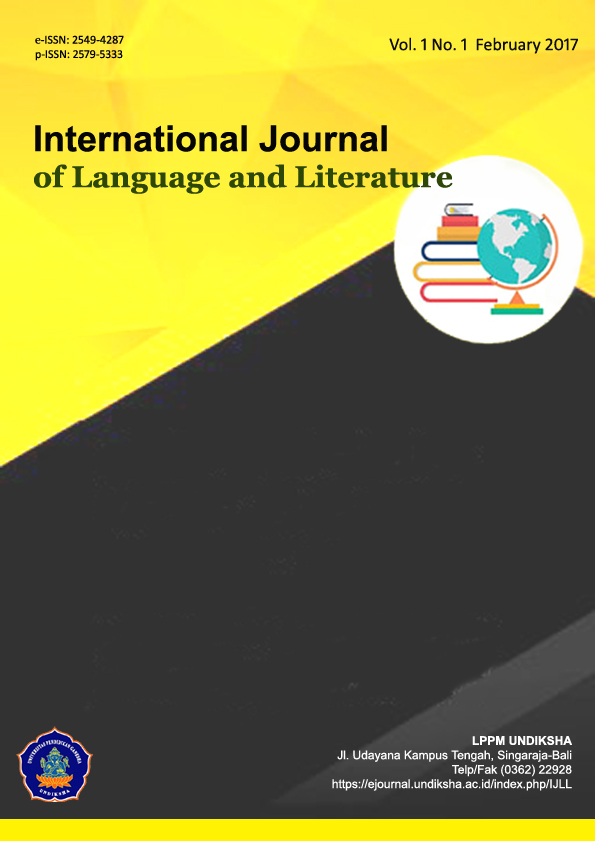TEACHERS’ PERCEPTION OF STUDENTS’ READINESS IN THE IMPLEMENTATION OF THE 21ST-CENTURY SKILLS IN PRIVATE PRIMARY SCHOOLS
DOI:
https://doi.org/10.23887/ijll.v4i4.32079Keywords:
perception, readiness, 21st century skillsAbstract
This research was examined the teachers’ readiness for the implementation of 21st century skills in teaching English in private primary schools in Buleleng. The research was done in North Bali Bilingual School and SD Mutiara. The respondents involved in this research were 15 respondents. There were English teachers, teachers who use English as the medium of instruction, and the headmaster of the schools was becoming the research subject. The teachers’ readiness were analyzed from perceived readiness and observed readiness. However, this article focused on the teachers’ perception of students’ readiness in the implementation of 21st century skills. The results of this research represented how the teachers understand the usage skills in implementing the 21st century skills. The results of this present research indicated that the students from private primary schools were ready to apply to 21st century skills.
References
Boholano, H. (2017). Smart social networking: 21st century teaching and learning skills. Research in Pedagogy, 7(1), 21–29. https://doi.org/10.17810/2015.45 DOI: https://doi.org/10.17810/2015.45
Dalton, C. C., & Gottlieb, L. N. (2003). The concept of readiness to change. Journal of Advanced Nursing, 42(2), 108–117. https://doi.org/10.1046/j.1365-2648.2003.02593.x DOI: https://doi.org/10.1046/j.1365-2648.2003.02593.x
Etor, C. R., Mbon, U. F., & Ekanem, E. E. (2013). Primary education as a foundation for qualitative higher education in nigeria. Journal of Education and Learning, 2(2). https://doi.org/10.5539/jel.v2n2p155 DOI: https://doi.org/10.5539/jel.v2n2p155
Handayani, N. (2017). Becoming the effective English teachers in the 21st century: what should know and ehat should do? 1st English Language and Literature International Conference (ELLiC), 156–164.
Husin, M., Awang, M. M., & Ahmad, A. (2017). Teacher readiness in teaching and learning history process through i-think mind maps. Yupa: Historical Studies Journal, 1(2), 183–198. https://doi.org/10.26523/yupa.v1i2.66 DOI: https://doi.org/10.30872/yupa.v1i2.109
Jan, H. (2017). Teacher of 21 st century: characteristics and development. Research on Humanities and Social Sciences, 7(9), 50–54. www.iiste.org
Learning, P. for 21st C. (2010). 21st century knowledge and skills in ducator preparation. In 21st Century Knowledge and Skills in Educatior Preparation (Issue September). https://doi.org/10.1787/9789264193864-en DOI: https://doi.org/10.1787/9789264193864-en
Lim, K., & Tay, E. (2016). Preparing Teachers for the 21st Century. AsTEN Journal of Teacher Education, 1(1).
Mahanal, S. (2014). Peran guru dalam melahirkan generasi emas dengan keterampilan abad 21. Seminar Nasional Pendidikan HMPS Pendidikan Biologi FKIP Universitas Halu Oleo, 1(September), 1–16.
Mcdonald, S. M. (2011). Perception: a concept analysis 1. 1–18. DOI: https://doi.org/10.1111/j.1744-618X.2011.01198.x
Mustafa, D. (2014). Responding to the demand of 21st century teaching and learning : the case of higher education in Indonesia. Profesional Development in Education, 80–88.
Pratiwi, N. M. R. H., Padmadewi, N. N., & Paramartha, A. A. G. . (2019). A study on the literacy-rich classroom environment at bilingual kindergarten singaraja. International Journal of Language and Literature, 3(2), 68–77. DOI: https://doi.org/10.23887/ijll.v3i2.20844
Qiong, O. U. (2017). A brief introduction to perception. Studies in Literature and Language, 15(4), 18–28. https://doi.org/10.3968/10055
Rinaldi, I., & Saroh, Y. (2017). The rise of national plus school in Indonesia – education for parents and government. Lingua Didaktika: Jurnal Bahasa Dan Pembelajaran Bahasa, 10(2), 194–205. https://doi.org/10.24036/ld.v10i2.7322 DOI: https://doi.org/10.24036/ld.v10i2.7322
Rusdin, N. M. (2018). Teachers’ readiness in implementing 21st century learning. International Journal of Academic Research in Business and Social Sciences, 8(4), 1293–1306. https://doi.org/10.6007/ijarbss/v8-i4/4270 DOI: https://doi.org/10.6007/IJARBSS/v8-i4/4270
Saputri, D. A. (2016). Analysis of teachers’ readiness in teaching English to young learners at kindergartens (A study of the kindergartens in Salatiga in the academic year of 2015 / 2016 ).
Shum, S. B., & Crick, R. D. (2016). Learning analytics for 21st century competencies. Journal of Learning Analytics, 3(2), 6–21. https://doi.org/S0167-4781(97)00063-8 [pii] DOI: https://doi.org/10.18608/jla.2016.32.2
Sumual, M. Z. I., & Ali, M. (2017). Evaluation of primary school teachers’ pedagogical competence in implementing curriculum. Journal of Education and Learning, 11(3), 343–350. DOI: https://doi.org/10.11591/edulearn.v11i3.6429
Syamsuri, H. A. S., & Ishaq. (2010). Guru, generasi Z, dan alah : pembelajaran abad 21. Repositori Unismuh.Ac.Id, 1–15.
Triling, B., & Fadel, C. (2009). 21st century skills. Learning for life in our times (first edition). In Jossey-Bass (Issue Book).
Tuzlukova, V., Al Busaidi, S., Burns, S., & Bugon, G. (2018). Exploring teachers’ perceptions of 21St century skills in teaching and learning in English language classrooms in Oman’s higher education institutions. Journal of Teaching English for Specific and Academic Purposes, 6(1), 191. https://doi.org/10.22190/jtesap1801191t DOI: https://doi.org/10.22190/JTESAP1801191T
Zubaidah, S. (2016). Keterampilan abad ke-21 : keterampilan yang diajarkan melalui pembelajaran. Seminar Nasional Pendidikan, 21(2), 1–17.
Downloads
Published
How to Cite
Issue
Section
License
IJLL Journal provides immediate open access to its content on the principle that making research freely available to the public to supports a greater global exchange of knowledge.

This work is licensed under a Creative Commons Attribution-ShareAlike 4.0 International License







